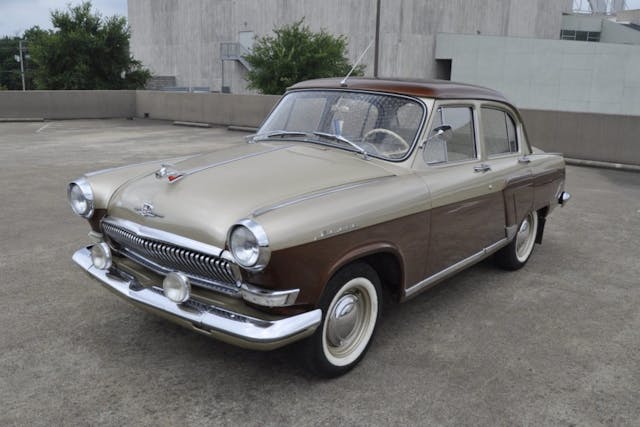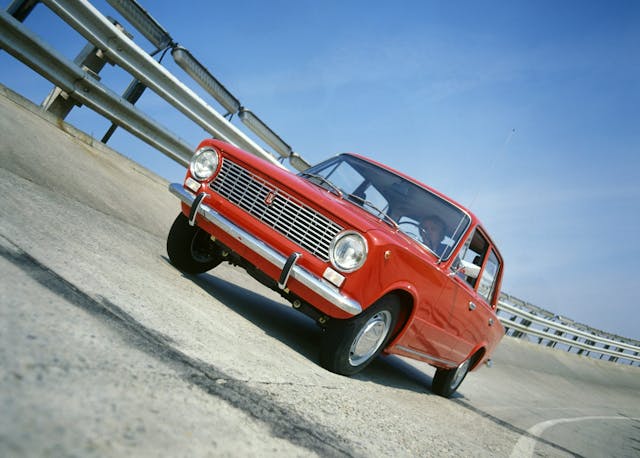Collectors are beginning to take note of Russian cars
The average American car enthusiast has historically known little to nothing about Soviet cars. That appears to be changing. As American pop culture has begun taking a more nuanced look at Soviet culture over the past decade with hit shows like The Americans, car enthusiasts—particularly younger ones—are starting to appreciate some of the metal produced behind the Iron Curtain.
Professor Lewis Siegelbaum, now retired from Michigan State University, has been ahead of this curve. Back in 2008, he published one of the most comprehensive compendiums in existence on Soviet automotive history, entitled Cars for Comrades. The book covers an incredible amount of ground, ranging from the origin stories of some of the USSR’s most iconic cars to the infamously unreliable state of its roads and the emergence of a uniquely Soviet car culture, all while examining the tension between Soviet ideology and the automobile as a classic symbol of American individualism and consumerism.
“The automobile and Soviet Communism made an odd couple,” Siegelbaum notes in his preface. “Unlike some other modes of transportation—trains, airplanes, tractors—cars had rarely served as icons of the Soviet march to the bright socialist future.”
Cars for Comrades is a must read for anyone interested in Soviet history or out-of-the-ordinary cars. In the interest of dipping one’s toe into the proverbial Lake Baikal that is the enormous and complex history of the Soviet automobile, we’ve presented some highlights, along with Hagerty data on the potential collectability of some of the most notable vehicles.
AMO-ZIS-ZIL (or just “ZIL”)

The Moscow Automotive Society (AMO), known alternatively as “ZIS” or “ZIL,” is the only manufacturer on this list to have existed before, during, and after the existence of the Soviet Union. In fact, AMO was one of the five private companies that received contracts to produce motor vehicles for the Russian Imperial Army during World War I. AMO somehow managed to survive the Russian Civil War and find its place within the new Socialist state as “ZIS” under Stalin as he, somewhat surprisingly, emphasized the importance of bringing “American efficiency” into the new Soviet era. It also outlasted the subsequent De-Stalinization efforts as the newly christened “ZIL,” renamed for its longtime director Ivan Likhachev. Nowadays, ZIL is no more. Though it is unclear if the company technically, legally still “exists,” it was declared bankrupt in 2013 and no longer produces cars.
While AMO-ZIS-ZIL never fully achieved the dream of reaching American levels of mass production, it did manage to carve out a niche as a high-quality Soviet car. ZIS and ZIL limousines were the ultimate in Soviet automotive luxury and the official cars of Soviet heads of state. In Comrades, Siegelbaum refers to them as the “Cadillac of the Soviet automobile fleet”—or alternatively the Packard, given the longstanding dispute among auto enthusiasts around whether the ZIS-110 used Packard body dies or if the factory fabricated its own.
Perhaps this controversy around the ZIS-110 persists because the car is particularly emblematic of this manufacturer’s commitment to quality and symbolic importance. With production ongoing from 1945–58, this 2.8-ton beautiful beast of a machine had a 140-hp. 6.0-liter, straight-eight engine that enabled speeds of up to 140 km/h (87 mph). The 110 was the first Soviet car to boast independent front suspension, front and rear axle stabilizers, and, like the Packard 180 that it was based on, power windows.
Fewer than 2100 ZIS-110s were produced, and far fewer remain today. In fact, Hagerty insures only one. Much like the Mercedes-Benz 600 Grosser, the value of a ZIS 110 is influenced by which dictator or high-ranking parting member it belonged to. If and when a ZIS 110 finally comes to auction, it will likely sell in the mid-six figures. If it was owned by Stalin himself, a couple million should do.
GAZ-21 (aka the Volga)

During the Cold War, the Gorky Automobile Factory (GAZ), located in the city now called Nizhny Novgorod, was possibly the closest thing to a fully realized Soviet Detroit in terms of both output and technological prowess. This makes sense considering that the factory was born out of an agreement in 1929 between the USSR and the Ford Motor Company, under which Ford would provide a detailed design for the plant and technical expertise in exchange for the Soviet Union purchasing a specified amount of parts and vehicles, among other stipulations. Although it has since been through many ups and downs—most recently it was badly impacted by U.S.-government sanctions—the company survives to this day.
Originally, the plant sprung to life turning out Model A Fords. However, GAZ ultimately moved toward designing its own models independent from its American partner. One of GAZ’s more famous “signature” cars was introduced in 1956 as the GAZ-21, the first car of the popular Volga family (named after the Volga River, near which the automaker is situated). Although much of its styling was borrowed from many American cars of the day, GAZ passed over the “uneconomical” large overhangs and rear fins, instead focusing on passenger space. The Volga came standard with features its American counterparts often lacked, including a reclining front bench, cigarette lighter, and radio.
The GAZ-21 was powered by a reliable 2.5-liter inline-four engine that produced 70 hp and a very impressive 123 lb-ft of torque. Its renowned durability made the versatile Volga a popular workhorse in the Soviet taxi fleet, and the 9.1-inch ground clearance made it a regular presence at rally events throughout Europe—one even earned a class win at the 1959 Thousand Lakes Rally in Finland.
Roughly 640,000 GAZ-21 Volgas were built across three series from 1956–70, and Siegelbaum notes, “It is hard to picture Soviet towns in the 1960s without these vehicles gathered outside regional party headquarters and other important buildings.” With its mid-century styling, chrome bumpers, and a current value around $21,000, the Volga is likely the most approachable Soviet classic for Americans. Jay Leno even added a 1963 GAZ-21 to his ever-growing collection back in 2013.
VAZ (Togliatti)—Lada

Similar to the heavily Ford-reliant origins of GAZ, the Volga Automotive Plant, or VAZ, came out of a deal with Fiat in 1966 to build an integrated auto factory. At this point in the Cold War, a partnership with an American or West German firm was politically out of the question, and so Fiat was able to land the “deal of the century”—valued around $900 million (or about $7.6 billion today). As in the GAZ deal with Ford, Fiat was to provide technical assistance and training to produce a car similar to its existing models. To honor their Italian comrades, the town that developed around the factory was named after one of the founders of the Italian Communist Party, Palmiro Togliatti.
Siegelbaum suggests that VAZ’s distinguishing characteristic was its “youthfulness” and its catering to the average Soviet citizen. VAZ’s flagship car certainly supports this theory and is perhaps the best-known of any Soviet vehicle—the Lada. Officially called the VAZ-2101 and known as the “Zhiguli” domestically, its affordability and ease of repair are often cited as significant factors for its continued relevance and initial place as the Soviet “people’s car.” The first Lada rolled off the line in 1970 and was pitched as a more rugged version of the Fiat-124 sedan, with a thicker-gauge steel body and higher ground clearance that allowed it to better traverse infamously bumpy Soviet roads and harsh winters. Due to the durability modifications, the Lada weighed 200 pounds more than the Fiat. It had a single overhead cam, 59-hp, 1198-cc engine with a top speed of 140 kmh (about 87 mph).
Notably, the Lada also sold fairly well outside of the USSR and almost made it to the U.S. market in the ’70s, but it was kept out mainly because U.S. politicians reasoned that American auto manufacturers were already struggling without the addition of cheaper Communist competition. However, there may still be hope. VAZ ultimately morphed into AvtoVaz when it was privatized in 1993 after the end of the Soviet Union, and the factory remains one of the largest car manufacturers in Russia and Eastern Europe. Though the exact state of the current ownership is a bit murky, it appears Renault owns a controlling stake of the joint venture company that owns AvtoVaz, essentially rendering AvtoVaz a Renault subsidiary. Renault feels there is a lot of life left in the Lada name and is pushing it forward in the hope it will become an internationally-relevant brand.
Renault may be on to something, as Ladas seem to be the universal favorite among Soviet car enthusiasts—Siegelbaum included. He attributes their appeal to the fact that “they are not fancy, they smack of authenticity, and maybe also because they are disdained by older folks.” Due to their multi-million production numbers, most Ladas can be found for $10,000 or less.
American collectors of Soviet cars skew young, but this is especially true of Ladas, whose average owner is a sprightly 44—that’s 13 years younger than the typical classic car owner.
Millennials account for 33 percent of Lada ownership. It seems both the cheaper price point and more stereotypically “Soviet” appearance lines up well with the preferences of a generation that tends to value uniqueness and affordability (and maybe irony) over luxury. Young collectors are often the people who bring obscure cars into the mainstream classic car world. We could be on the verge of seeing this happen with Ladas.
From the first season of FX’s hit Cold War spy show The Americans in 2013 to the release of the 1980s Berlin-based thriller Atomic Blonde in 2017, yearly imports for Ladas and Volgas exploded. Since then, Volgas dropped off, while Ladas continue to be a consistent import from the old Eastern Bloc.
Seigelbaum does not try to convince the reader that the Soviet auto industry was any kind of model for success: "Neither cars nor the complex infrastructure needed to support them dominated the landscape as they did in the United States and other Western countries." That, along with the sheer production volumes, make it unlikely anyone will get rich hoarding Soviet classics. Don't be surprised, however, if you see more Ladas showing up at your local car shows.



